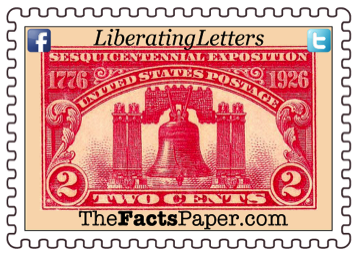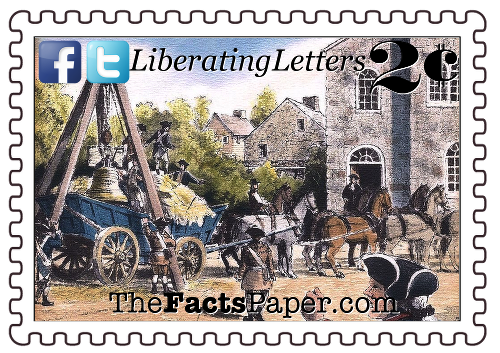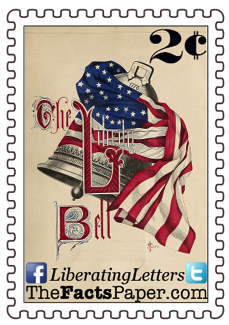The townspeople saved the Liberty Bell, but they lost their beloved Liberty Tree. (see Tree Of Liberty) After the British left Philadelphia in June 1778, the bell was returned to its proper home. However, since the State House steeple was in such disrepair, the bell was put in storage until 1785.
Over the years, the bell continued to be used at the State House without gaining much additional symbolism beyond the importance to Penn. It tolled to bid farewell to Benjamin Franklin when he left for England to discuss the colonists’ complaints face-to-face with Parliament. (see It Just Takes Common Sense and The Forgotten Founding Father) It tolled to announce King George III’s ascension to the throne in 1760. It also tolled to summon Philadelphians together to contemplate such controversial legislation as the 1764 Sugar Act and the 1765 Stamp Act. (see Acts Of Oppression). Plus, it announced the Battle of Lexington and Concord. (see The Shot Heart ‘Round The World)
All of these events are significant, but they did not transform it into the “Liberty Bell”. Not even its association with the Declaration did that. It wasn’t until abolitionists adopted the bell as a symbol of their movement did it get its new name.
Holding the Founders to the Constitution, abolitionists wanted freedom for ALL. The full verse of Leviticus 25:10 reads: “Consecrate the fiftieth year and proclaim liberty throughout the land to all its inhabitants. It shall be a jubilee for you; each of you is to return to your family property and to your own clan.” God instructed the Israelites to free slaves every 50 years, an action abolitionists desperately wanted in America. Because of its inscription, abolitionists gave it the name "Liberty Bell".
The New York anti-slavery society referred to the bell in a piece in the abolitionist Liberty journal in 1837, marrying it to the movement. Following the publication of an anti-slavery poem entitled, “The Liberty Bell”, the bell's iconic association with Liberty and the name Liberty Bell had begun.
On September 11, 1777, the British defeated General George Washington at the Battle of Brandywine, leaving Philadelphia, the revolutionary capital, defenseless. (see Pivot Points) Its citizens quickly took action in preparation for a British attack. Knowing items like bells would be confiscated and used for munitions, they removed the State House Bell from its steeple and sent it to Bethlehem on a wagon escorted by numerous guards. From there, locals moved it to Northampton Town, known today as Allentown, where it was hidden under floor boards at the Zion German Reformed Church.
July 8, 2017
Dear Liberty,
"Proclaim Liberty Throughout all the Land unto all the Inhabitants Thereof." (Leviticus 25:10)
These words grace the Pennsylvania State Bell that was commissioned in 1751 to celebrate the 50th Anniversary of William Penn's 1701 Charter of Privileges, Pennsylvania's original Constitution. When Penn came to America in 1682, he brought along his Christian belief of religious freedom, liberty, rights, and peaceful living for all inhabitants. (see The Unbroken Treaty) To honor that sentiment, then Pennsylvania Speaker Isaac Norris chose this specific passage to be placed on the bell to continue Penn's fight for "Liberty throughout all the Land".
The bell was ordered from a foundry in London, and it cracked on its first ringing. Local founders, John Stow and John Pass, recast the bell twice within three months, however unfixable cracks eventually develop. Experts theorize the chemical makeup of the metal proved to be too brittle and would continue to break apart no matter how many times it was recast.
While another bell was ordered in 1752, the original bell was placed in the State House steeple, being referred to as the State House Bell, and used to call meetings. In a letter dated October 16, 1755, Benjamin Franklin wrote, "Adieu. The Bell rings, and I must go among the Grave ones, and talk Politiks. [sic]"
With the start of the American Revolution, the 13 colonies sent delegates to the Pennsylvania State House as part of the Second Continental Congress to discuss America's future. (see The Forgotten Battle and The Shot Heard 'Round The World) After months of debate, Thomas Jefferson, with the help of John Adams, Benjamin Franklin, Roger Sherman, and Robert Livingston, presented their final version of the Declaration of Independence to the Congress on July 2, 1776. (see The Forgotten Midnight Ride and Happy Independence Day) The Congress officially accepted it on July 4th.
Contrary to popular belief, the bell was not rung on the actual “Independence Day”, at least not in relation to the Declaration. The misunderstanding is primarily due to an 1847 short story about the elderly bell ringer who tolled the bell after hearing Congress had declared independence. Because of the wide-spread popularity of the story, the association between the Declaration of Independence and the Liberty Bell was forever sewn into the fabric of America.
On July 8, 1776, the bell did toll to announce the public reading of the document by Colonel John Nix:
The bell continued to be rung to announce such occasions as 4th of July celebrations, Election Day, call to classes at nearby University of Pennsylvania (see "Higher" Education and Free Health Care The Biblical Way), Washington's Birthday and Chief Justice John Marshall's death in 1835. Some contend it is after this ringing that the current crack started as another Liberty article two years later illustrates it without the crack. The exact time of the final crack happened was never recorded and will probably never be known. Regardless, it was definitely there in the 1840's. The bell tolled its last time on George Washington's Birthday, 1846, when the crack grew too large to safely ring again.
In 1865, 0n the way back to Springfield, Illinois, President Abraham Lincoln's body was displayed in Independence Hall’s Assembly Room, or the Declaration Room, in Philadelphia. (see Civility War Ends) The Liberty Bell was situated at his head. Desperate for unity after the War Between the States, the Liberty Bell was sent across the country in efforts to bring Americans together, reminding them what we have in common, a desire for Liberty.
Until 1915, the Liberty Bell traveled the United States so people could see it and touch it. Unfortunately, many also damaged it as they chipped at it around the rim for souvenirs. On one such trip through Indianapolis, former President Benjamin Harrison commented, "This old bell was made in England, but it had to be re-cast in America before it was attuned to proclaim the right of self-government and the equal rights of men." On the other hand, others argued the crack symbolized the division America had for slaves' rights and Liberty at the time. Either way, the bell has become a national treasure to most Americans, much like the Declaration (see Happy Independence Day), the Constitution (see Constitution Day), the flag (see A Stitch In Time), and the Statue of Liberty (see Liberty Enlightening The World).
Liberty, my Liberating Letters are ringing the bell to call all to return to God, return to principles, return to liberty and return to freedom. Otherwise, Life, Liberty and The Pursuit of Happiness will fall as silent at the Liberty Bell itself. William Penn had it right and his bell still needs to stand for that freedom he insisted on so many years ago.
Let Liberty Ring!
That’s my 2 cents.
Love,
Mom
LET LIBERTY RING!



"When in the Course of Human events, it becomes necessary for one people to dissolve the political bands which have connected them with another, and to assume, among the Powers of the earth, the separate and equal station to which the Laws of Nature and of Nature's God entitle them, a decent respect to the opinions of mankind requires that they should declare the causes which impel them to the separation.”
"We hold these truths to be self-evident, that all men are created equal, that they are endowed by their Creator with certain unalienable Rights, that amoung these are Life, Liberty, and the pursuit of Happiness."


